Avoid losing your email account via fake "HSBC Transfer Request" emails
Phishing/ScamAlso Known As: "HSBC Transfer Request" phishing email
Get free scan and check if your device is infected.
Remove it nowTo use full-featured product, you have to purchase a license for Combo Cleaner. Seven days free trial available. Combo Cleaner is owned and operated by RCS LT, the parent company of PCRisk.com.
What kind of email is "HSBC Transfer Request"?
After reviewing the "HSBC Transfer Request" email, we determined that it is fake. The spam letter is presented as a banking transfer request from HSBC; this lure is used to deceive recipients into disclosing their email log-in credentials to a phishing website.
It must be stressed that this mail is not associated with HSBC Holdings plc or any other legitimate entities.
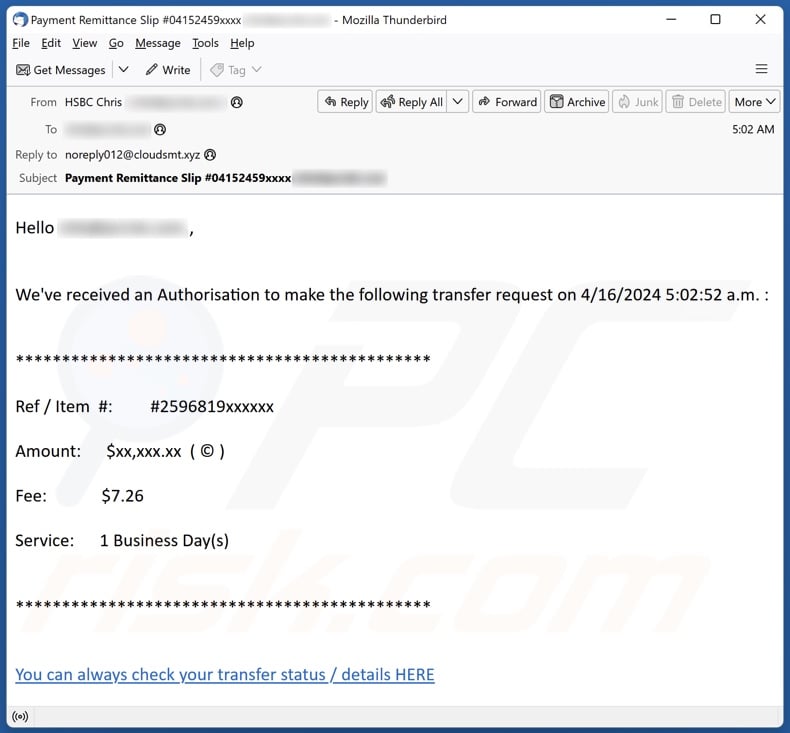
"HSBC Transfer Request" email scam overview
This spam email is presented as a message from HSBC. It states that authorization has been received to carry out a banking transfer request. The letter details the transaction and lists the associate fee – 7.26 USD. The email includes a link that recipients can follow for more information regarding this transfer.
As mentioned in the introduction, the claims made by this email are false, and this mail is in no way associated with HSBC Holdings plc (The Hongkong and Shanghai Banking Corporation) or any other genuine entities.
Pressing "You can always check your transfer status / details HERE" results in a redirect to a phishing website that imitates an email sign-in webpage. Information provided to this site is recorded and sent to cyber criminals.
The threats posed by having an email stolen are extensive; not only are the risks associated with the sensitivity of the data stored in the hijacked mail, but also with the potential theft of accounts/platforms registered through it.
To expand upon this, scammers can steal the identities of account owners (e.g., emails, social networking, social media, messengers, etc.) and request loans or donations from contacts/friends/followers, endorse scams, and proliferate malware by sharing malicious files/links.
Furthermore, finance-related accounts (e.g., e-commerce, digital wallets, money transferring, online banking, etc.) can be used to make fraudulent transactions and online purchases.
In summary, victims of scam mail like "HSBC Transfer Request" may experience severe privacy issues, financial losses, and even identity theft.
If you have already provided your log-in credentials to a phishing website – immediately change the passwords of all potentially compromised accounts and contact their official support.
| Name | "HSBC Transfer Request" phishing email |
| Threat Type | Phishing, Scam, Social Engineering, Fraud |
| Fake Claim | Request has been received for a banking transfer. |
| Disguise | HSBC |
| Related Domains | defendguard[.]top |
| Detection Names (defendguard[.]top) | N/A (VirusTotal) |
| Serving IP Address (defendguard[.]top) | 172.67.134.71 |
| Symptoms | Unauthorized online purchases, changed online account passwords, identity theft, illegal access of the computer. |
| Distribution methods | Deceptive emails, rogue online pop-up ads, search engine poisoning techniques, misspelled domains. |
| Damage | Loss of sensitive private information, monetary loss, identity theft. |
| Malware Removal (Windows) |
To eliminate possible malware infections, scan your computer with legitimate antivirus software. Our security researchers recommend using Combo Cleaner. Download Combo CleanerTo use full-featured product, you have to purchase a license for Combo Cleaner. 7 days free trial available. Combo Cleaner is owned and operated by RCS LT, the parent company of PCRisk.com. |
Phishing spam campaign examples
"Consignment Box", "Restore Email DNS", and "Email Is Due For Renewal" are just a couple examples of phishing campaigns we have researched recently.
Spam mail of this kind primarily targets the log-in credentials of various accounts, personally identifiable details, and finance-related information. However, deceptive emails are used to promote other scams as well, and they are used to distribute malware.
While the commonly held belief that spam emails are riddled with spelling/grammatical errors is not incorrect, it is not exclusively true. These letters can be competently crafted and even believably disguised as messages from genuine entities (e.g., companies, corporations, organizations, institutions, service providers, authorities, etc.).
How do spam campaigns infect computers?
Cyber criminals commonly use spam campaigns to spread malware. The emails/messages can have malicious files attached to or linked inside them. These files come in various formats, e.g., archives (ZIP, RAR, etc.), executables (.exe, .run, etc.), documents (Microsoft Office, Microsoft OneNote, PDF, etc.), JavaScript, and so on.
An infectious file initiates the malware download/installation chain upon being opened. Some formats need additional user interaction to trigger these processes. For example, Microsoft Office files require users to enable macro commands (i.e., editing/content), while OneNote documents need them to click embedded links or files.
How to avoid installation of malware?
We recommend exercising caution with incoming emails, PMs/DMs, SMSes, and other messages. Do not open attachments or links found in suspect/irrelevant mail, as they can be malicious. However, malware is not spread only through spam mail.
Therefore, be vigilant while browsing, as fraudulent and dangerous online content usually appears genuine and harmless.
Additionally, download only from official and verified channels. Activate and update programs using legitimate functions/tools, as illegal activation ("cracking") tools and third-party updates may contain malware.
It is paramount for device integrity and user safety to have a reputable anti-virus installed and kept up-to-date. Security software must be used to perform regular system scans and to remove detected threats/issues.
If you've already opened malicious attachments, we recommend running a scan with Combo Cleaner Antivirus for Windows to automatically eliminate infiltrated malware.
Text presented in the "HSBC Transfer Request" spam email letter:
Subject: Payment Remittance Slip #04152459xxxx ********
Hello ******** ,
We've received an Authorisation to make the following transfer request on 4/16/2024 5:02:52 a.m. :
*********************************************
Ref / Item #: #2596819xxxxxx
Amount: $xx,xxx.xx ( © )
Fee: $7.26
Service: 1 Business Day(s)
*********************************************
You can always check your transfer status / details HERE
Sincerely.
Anthony Dwyer
HSBC
Wire / Payment Transfer Department.
Appearance of the "HSBC Transfer Request" spam email (GIF):
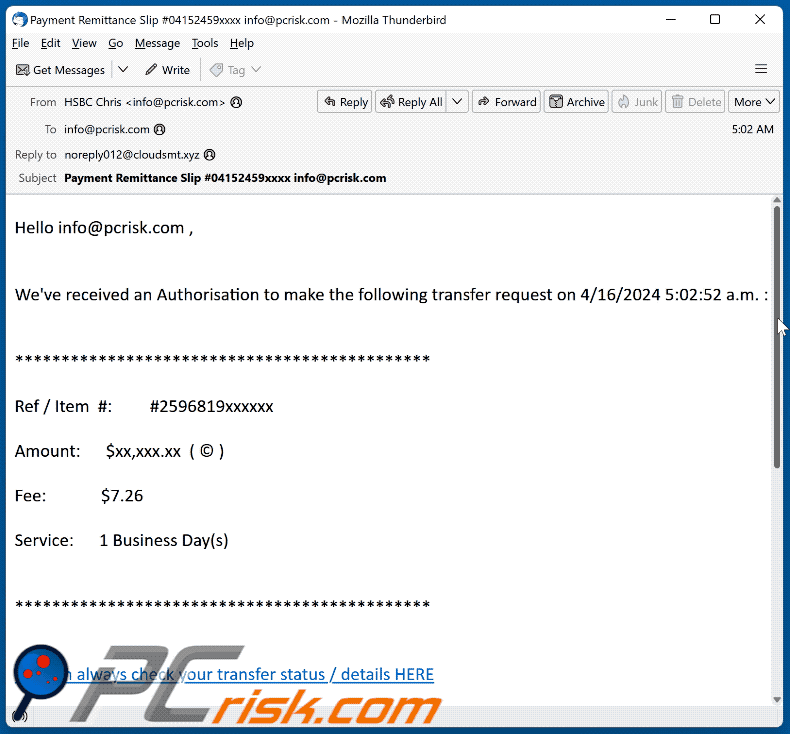
Screenshot of the phishing website promoted by the "HSBC Transfer Request" spam campaign:
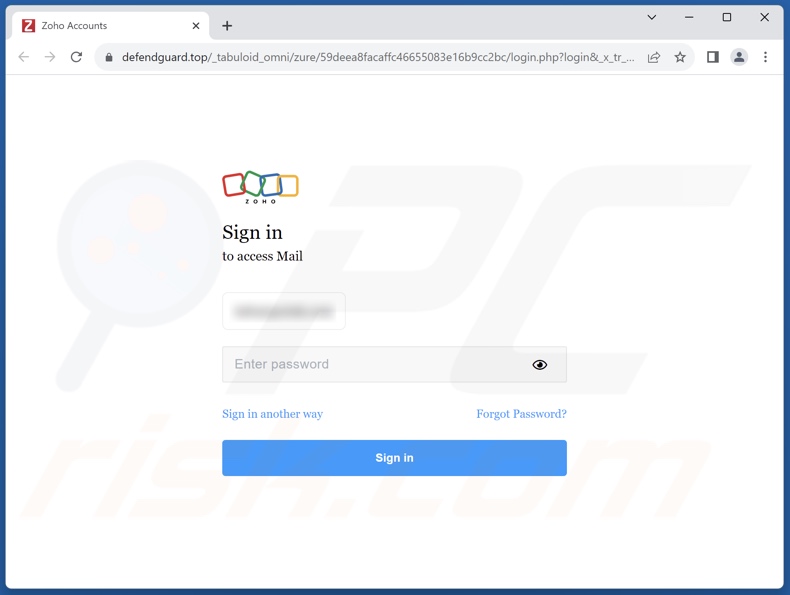
Another example of an email from "HSBC Transfer Request" spam campaign:
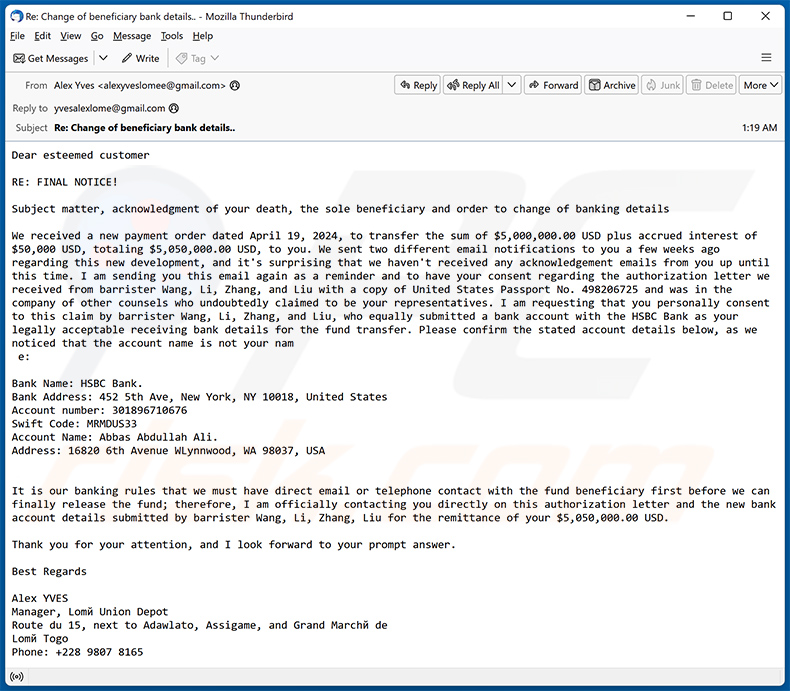
Text presented within:
Subject: Re: Change of beneficiary bank details..
Dear esteemed customer
RE: FINAL NOTICE!
Subject matter, acknowledgment of your death, the sole beneficiary and order to change of banking details
We received a new payment order dated April 19, 2024, to transfer the sum of $5,000,000.00 USD plus accrued interest of $50,000 USD, totaling $5,050,000.00 USD, to you. We sent two different email notifications to you a few weeks ago regarding this new development, and it's surprising that we haven't received any acknowledgement emails from you up until this time. I am sending you this email again as a reminder and to have your consent regarding the authorization letter we received from barrister Wang, Li, Zhang, and Liu with a copy of United States Passport No. 498206725 and was in the company of other counsels who undoubtedly claimed to be your representatives. I am requesting that you personally consent to this claim by barrister Wang, Li, Zhang, and Liu, who equally submitted a bank account with the HSBC Bank as your legally acceptable receiving bank details for the fund transfer. Please confirm the stated account details below, as we noticed that the account name is not your nam
e:Bank Name: HSBC Bank.
Bank Address: 452 5th Ave, New York, NY 10018, United States
Account number: 301896710676
Swift Code: MRMDUS33
Account Name: Abbas Abdullah Ali.
Address: 16820 6th Avenue WLynnwood, WA 98037, USA
It is our banking rules that we must have direct email or telephone contact with the fund beneficiary first before we can finally release the fund; therefore, I am officially contacting you directly on this authorization letter and the new bank account details submitted by barrister Wang, Li, Zhang, Liu for the remittance of your $5,050,000.00 USD.Thank you for your attention, and I look forward to your prompt answer.
Best Regards
Alex YVES
Manager, Lomй Union Depot
Route du 15, next to Adawlato, Assigame, and Grand Marchй de
Lomй Togo
Phone: +228 9807 8165
Instant automatic malware removal:
Manual threat removal might be a lengthy and complicated process that requires advanced IT skills. Combo Cleaner is a professional automatic malware removal tool that is recommended to get rid of malware. Download it by clicking the button below:
DOWNLOAD Combo CleanerBy downloading any software listed on this website you agree to our Privacy Policy and Terms of Use. To use full-featured product, you have to purchase a license for Combo Cleaner. 7 days free trial available. Combo Cleaner is owned and operated by RCS LT, the parent company of PCRisk.com.
Quick menu:
- What is "HSBC Transfer Request" phishing email?
- Types of malicious emails.
- How to spot a malicious email?
- What to do if you fell for an email scam?
Types of malicious emails:
![]() Phishing Emails
Phishing Emails
Most commonly, cybercriminals use deceptive emails to trick Internet users into giving away their sensitive private information, for example, login information for various online services, email accounts, or online banking information.
Such attacks are called phishing. In a phishing attack, cybercriminals usually send an email message with some popular service logo (for example, Microsoft, DHL, Amazon, Netflix), create urgency (wrong shipping address, expired password, etc.), and place a link which they hope their potential victims will click on.
After clicking the link presented in such email message, victims are redirected to a fake website that looks identical or extremely similar to the original one. Victims are then asked to enter their password, credit card details, or some other information that gets stolen by cybercriminals.
![]() Emails with Malicious Attachments
Emails with Malicious Attachments
Another popular attack vector is email spam with malicious attachments that infect users' computers with malware. Malicious attachments usually carry trojans that are capable of stealing passwords, banking information, and other sensitive information.
In such attacks, cybercriminals' main goal is to trick their potential victims into opening an infected email attachment. To achieve this goal, email messages usually talk about recently received invoices, faxes, or voice messages.
If a potential victim falls for the lure and opens the attachment, their computers get infected, and cybercriminals can collect a lot of sensitive information.
While it's a more complicated method to steal personal information (spam filters and antivirus programs usually detect such attempts), if successful, cybercriminals can get a much wider array of data and can collect information for a long period of time.
![]() Sextortion Emails
Sextortion Emails
This is a type of phishing. In this case, users receive an email claiming that a cybercriminal could access the webcam of the potential victim and has a video recording of one's masturbation.
To get rid of the video, victims are asked to pay a ransom (usually using Bitcoin or another cryptocurrency). Nevertheless, all of these claims are false - users who receive such emails should ignore and delete them.
How to spot a malicious email?
While cyber criminals try to make their lure emails look trustworthy, here are some things that you should look for when trying to spot a phishing email:
- Check the sender's ("from") email address: Hover your mouse over the "from" address and check if it's legitimate. For example, if you received an email from Microsoft, be sure to check if the email address is @microsoft.com and not something suspicious like @m1crosoft.com, @microsfot.com, @account-security-noreply.com, etc.
- Check for generic greetings: If the greeting in the email is "Dear user", "Dear @youremail.com", "Dear valued customer", this should raise suspiciousness. Most commonly, companies call you by your name. Lack of this information could signal a phishing attempt.
- Check the links in the email: Hover your mouse over the link presented in the email, if the link that appears seems suspicious, don't click it. For example, if you received an email from Microsoft and the link in the email shows that it will go to firebasestorage.googleapis.com/v0... you shouldn't trust it. It's best not to click any links in the emails but to visit the company website that sent you the email in the first place.
- Don't blindly trust email attachments: Most commonly, legitimate companies will ask you to log in to their website and to view any documents there; if you received an email with an attachment, it's a good idea to scan it with an antivirus application. Infected email attachments are a common attack vector used by cybercriminals.
To minimise the risk of opening phishing and malicious emails we recommend using Combo Cleaner Antivirus for Windows.
Example of a spam email:
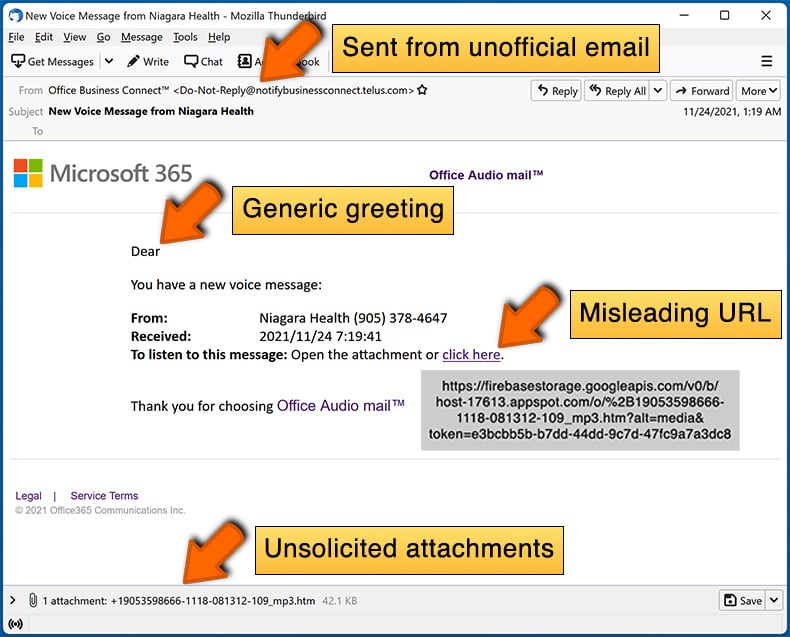
What to do if you fell for an email scam?
- If you clicked on a link in a phishing email and entered your password - be sure to change your password as soon as possible. Usually, cybercriminals collect stolen credentials and then sell them to other groups that use them for malicious purposes. If you change your password in a timely manner, there's a chance that criminals won't have enough time to do any damage.
- If you entered your credit card information - contact your bank as soon as possible and explain the situation. There's a good chance that you will need to cancel your compromised credit card and get a new one.
- If you see any signs of identity theft - you should immediately contact the Federal Trade Commission. This institution will collect information about your situation and create a personal recovery plan.
- If you opened a malicious attachment - your computer is probably infected, you should scan it with a reputable antivirus application. For this purpose, we recommend using Combo Cleaner Antivirus for Windows.
- Help other Internet users - report phishing emails to Anti-Phishing Working Group, FBI’s Internet Crime Complaint Center, National Fraud Information Center and U.S. Department of Justice.
Frequently Asked Questions (FAQ)
Why did I receive this email?
Regardless of any relevant details that they may include, spam emails are not personal. This mail is sent out in massive operations – hence, thousands of users receive identical messages.
I have provided my personal information when tricked by this spam email, what should I do?
If you have disclosed your log-in credentials – change the passwords of all potentially exposed accounts and inform their official support without delay. However, if the provided information was of a different personal nature (e.g., ID card details, passport scans/photos, credit card numbers, etc.) – immediately contact the corresponding authorities.
I have read a spam email but didn't open the attachment, is my computer infected?
Devices are compromised when malicious attachments or links are opened/clicked; merely reading an email poses no infection threat.
I have downloaded and opened a file attached to a spam email, is my computer infected?
Whether the system was infected might depend on the format of the opened file. If it was an executable (.exe, .run, etc.) – most likely, yes – since these files cause infections almost without fail. However, you might have avoided this if it was a document (.doc, .xls, .one, .pdf, etc.). These formats may require additional actions (e.g., enabling macro commands, clicking embedded content, etc.) to begin downloading/installing malware.
Will Combo Cleaner remove malware infections present in email attachments?
Yes, Combo Cleaner is capable of detecting and eliminating nearly all known malware infections. It must be stressed that since sophisticated malicious programs usually hide deep within systems – running a complete system scan is key.
Share:

Tomas Meskauskas
Expert security researcher, professional malware analyst
I am passionate about computer security and technology. I have an experience of over 10 years working in various companies related to computer technical issue solving and Internet security. I have been working as an author and editor for pcrisk.com since 2010. Follow me on Twitter and LinkedIn to stay informed about the latest online security threats.
PCrisk security portal is brought by a company RCS LT.
Joined forces of security researchers help educate computer users about the latest online security threats. More information about the company RCS LT.
Our malware removal guides are free. However, if you want to support us you can send us a donation.
DonatePCrisk security portal is brought by a company RCS LT.
Joined forces of security researchers help educate computer users about the latest online security threats. More information about the company RCS LT.
Our malware removal guides are free. However, if you want to support us you can send us a donation.
Donate
▼ Show Discussion